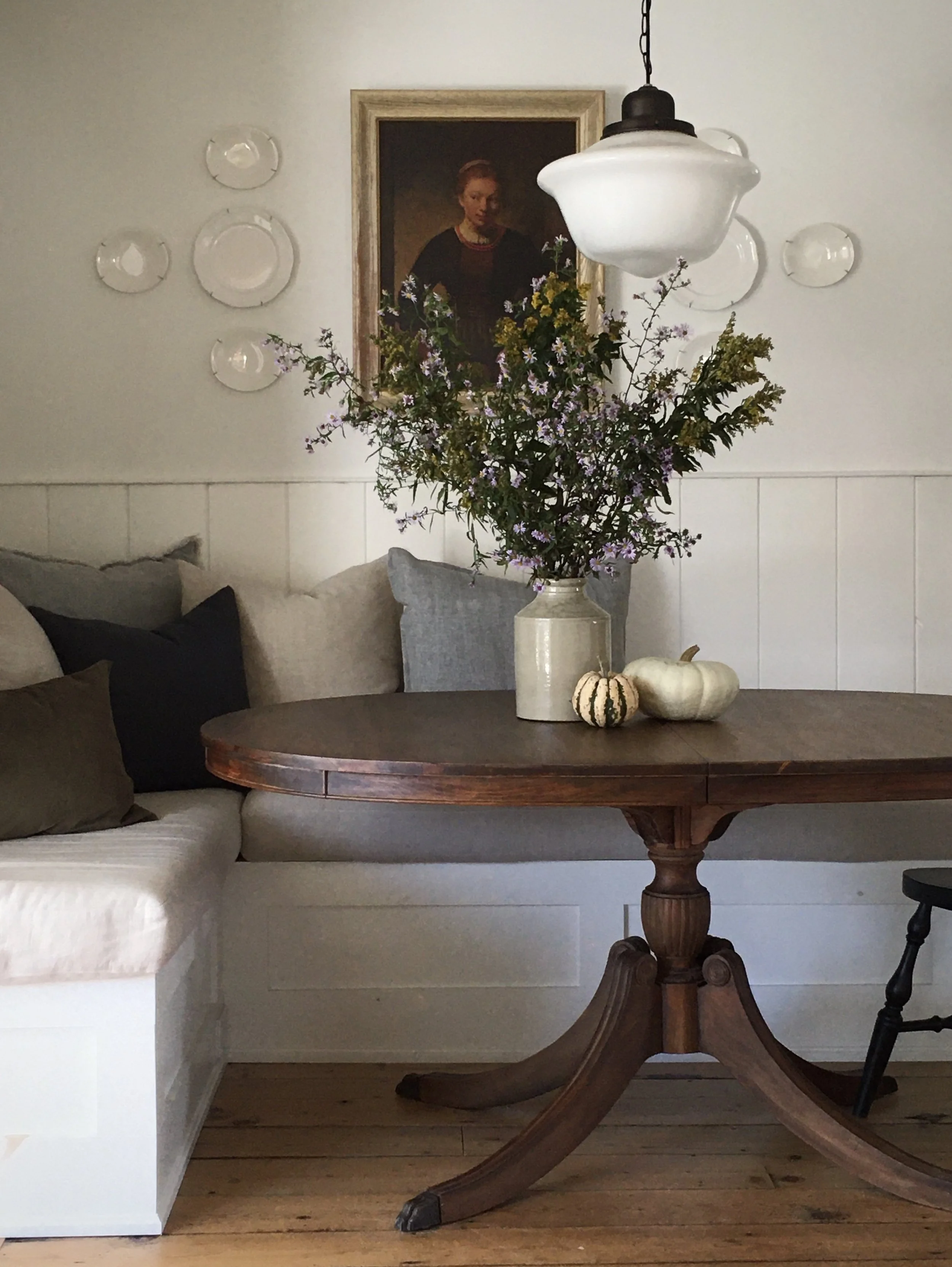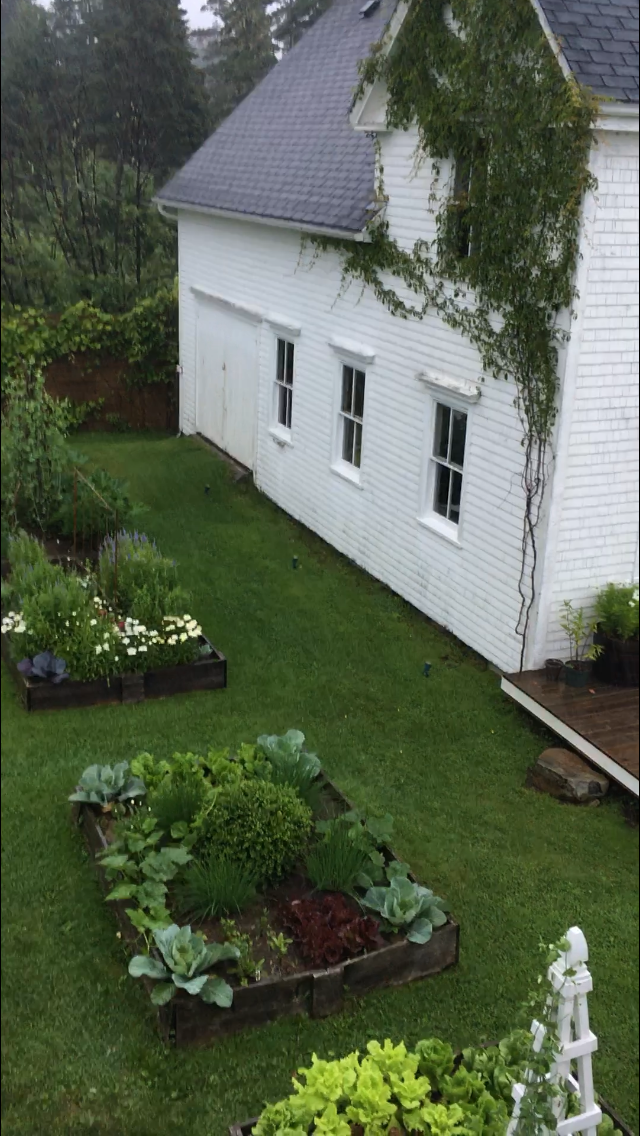A late 19th century workshop
I’ve shared random images of our guest barn interior on Instagram and within other blog posts over the past few years but I haven’t featured them here in one blog post yet so here goes.
The barn is situated fairly close to the house, we’ve learned it was built in the late 1800’s or at the turn of the century, and approximately 25 years after the house was built. Located on the shores of what was and still is a fishing community it was built by the owner who was a carpenter by trade. Although we’ve always referred to it as a barn it was actually built for his workshop, it’s never been used to house animals. Wooden lobster traps were one of the things that were produced in the shop and there was also a mill located beside the creek at the front or our property. The style of house is referred to as a Carpenter Gothic or in Atlantic Canada its also known as a Fisherman’s Gothic.
When we purchased the property the barn was in solid condition although completely unfinished on the interior., it had been constructed entirely from sold timber posts and beams on a stone foundation with plank floors and walls and cedar shake cladding. It had electricity but otherwise was in its original condition showing the character of all its 100+ years age. We first began cosmetically transforming the main level to use as seasonal space back in 2017 and its evolved a bit every year since but still remains very much original and un-winterized and without plumbing.
Shortly after we built the potager garden we added new porch decks to the house and barn, designed to also connect the two buildings via a ‘boardwalk’. This has been transformative - its such a simple luxury to go back and forth between both buildings without walking through wet grass - grass which is wet here a lot! (in the image below the ‘boardwalk’ connecting the two porches is to the left, just out of camera view but we usually call it the cat walk because it was needed as much (more) for the cat than us.
Above, my Niece basking in the sun during a past very warm Thanksgiving week. We put a new pair of glass french doors on the side entrance of the barn (this is the side facing the house) behind the original storm doors. We added a secondary set of screen doors too but rarely use them and this year didn’t even put them on because the summer was so rainy.
The view looking out from the barn (above), this was when the new porch decks were still being worked on. The beach is in the distance although fog was coming in, when its clearer you can see it more clearly and beyond out to the ocean..
On the inside the first thing we did was partition off an area at the back of the main level of the barn so we could continue to use that space as a workshop, it has large double barn doors that open up into the potager garden. We built the wall as a simple horizontal plank wall with jib door. This separation created a good size lounge space to furnish, with access to the second level. Next we replaced the existing steep ladder-like steps that led up to the second floor with a more functional staircase, and finished it by enclosing the staircase. Then EVERYTHING except the ceiling got coated in paint.
The first pieces of furniture we put in were a pair of day beds that I designed, each are Twin XL in size which can be butted together to make a king bed. Currently we mainly use them like sofas for lounging since we now have a guest bedroom in the upstairs of the barn. Ultimately I hope to move these upstairs too into separate bunk nooks.
A few local antiques and lots of vintage nautical and marine pieces and a striped jute rug make up the rest of the decor. Macausland wool blankets from PEI covered the day beds initially.
A 19th century nova scotia pine jamb cupboard and an windsor chair from the same era.
An antique organ that came with the barn but are impossible to find anyone to haul away even if you pay them,,,, a nuisance to move around, it got a coat of paint. For now its just taking up space as a plant stand and display ledge until we’re ready to embark on more changes in the space. Eventually the organ will get moved out piece by piece with the assistance of a sledge-hammer.
An antique wicker chair and a vintage model of the Bluenose schooner were the first finds for the space, both from local antique shops. My late brother and another brother made the coffee table from salved planks we pulled from the house’s attic years ago and an old wharf beam we found washed up on the beach. Last year I had custom mattress covers and pillows made for the beds (above) but not all of the pillow covers were finished before the end of the season (fabric stock issue) so this summer was our first full season with them.
I used a true mattress ticking fabric for the bed covers and stone washed cotton for the pillows. (Sources and details were in our Summer Newsletter!).
Back in 2021 we built a mini bar under the staircase. We used salvaged antique boards for the shelves and countertop, clad the walls in shiplap and hung a linen curtain to conceal a a fridge and some open shelving for ice buckets, trays and recyclables. I painted the ship lap a deep dark brown. I’m on the hunt for a marine style vintage bulkhead light.
This compact mini bar has really worked big for for us, the fridge holds a huge supply of canned and bottled drinks plus more, and the shelves hold plenty of spirits and glasses. We’re always serving up snacks in here so small plates and bowls are on hand too. This fall I lined the shelves with brown transferware which swapped out my great great aunts plates with wild rose pattern which created a very english garden tea party vibe. The antique ladder chair was a recent roadside freebie, just resting here before it heads into the workshop.
The fall is always my favourite time to use this building, here in Nova Scotia its the most enjoyable weather of the year and October gifts us with spectacular autumn colours and summer-like temps. The barn provides a cozy sheltered space to extend the outdoor season and a casual place to socialize when friends or neighbours drop by. Its also the perfect hang out space when family visits (yahtzee and puzzles being the fave pastimes!). I’ll share a peek of the upstairs bedroom space in a Part 2 post.
Here’s a previous post with a look at the Barn BEFORE we began updates and added the potager garden.






























